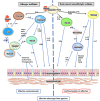Overuse of Short-Acting Beta-2 Agonists (SABAs) in Elite Athletes: Hypotheses to Explain It
- PMID: 35324645
- PMCID: PMC8952427
- DOI: 10.3390/sports10030036
Overuse of Short-Acting Beta-2 Agonists (SABAs) in Elite Athletes: Hypotheses to Explain It
Abstract
The use of short-acting beta-2 agonists (SABAs) is more common in elite athletes than in the general population, especially in endurance sports. The World Anti-Doping Code places some restrictions on prescribing inhaled β2-agonists. These drugs are used in respiratory diseases (such as asthma) that might reduce athletes' performances. Recently, studies based on the results of the Olympic Games revealed that athletes with confirmed asthma/airway hyperresponsiveness (AHR) or exercise-induced bronchoconstriction (EIB) outperformed their non-asthmatic rivals. This overuse of SABA by high-level athletes, therefore, raises some questions, and many explanatory hypotheses are proposed. Asthma and EIB have a high prevalence in elite athletes, especially within endurance sports. It appears that many years of intensive endurance training can provoke airway injury, EIB, and asthma in athletes without any past history of respiratory diseases. Some sports lead to a higher risk of asthma than others due to the hyperventilation required over long periods of time and/or the high environmental exposure while performing the sport (for example swimming and the associated chlorine exposure). Inhaled corticosteroids (ICS) have a low efficacy in the treatment of asthma and EIB in elite athletes, leading to a much greater use of SABAs. A significant proportion of these high-level athletes suffer from non-allergic asthma, involving the th1-th17 pathway.
Keywords: asthma; doping; exercise-induced bronchoconstriction; overuse; short-acting beta-2 agonists; sport.
Conflict of interest statement
The authors declare no conflict of interest.
Figures
References
-
- Coëtmeur D., Parrat E., Nocent-Ejnaini C., Magiapan G., Prud’homme A., Oster J.-P., Appere de Vecchi C., Maurer C., Raherison C., Debieuvre D., et al. Activité physique et asthme sévère: Résultats de l’étude FASE-CPHG. Rev. Des Mal. Respir. 2020;37:320–327. doi: 10.1016/j.rmr.2019.12.004. - DOI - PubMed
Publication types
LinkOut - more resources
Full Text Sources
Miscellaneous


